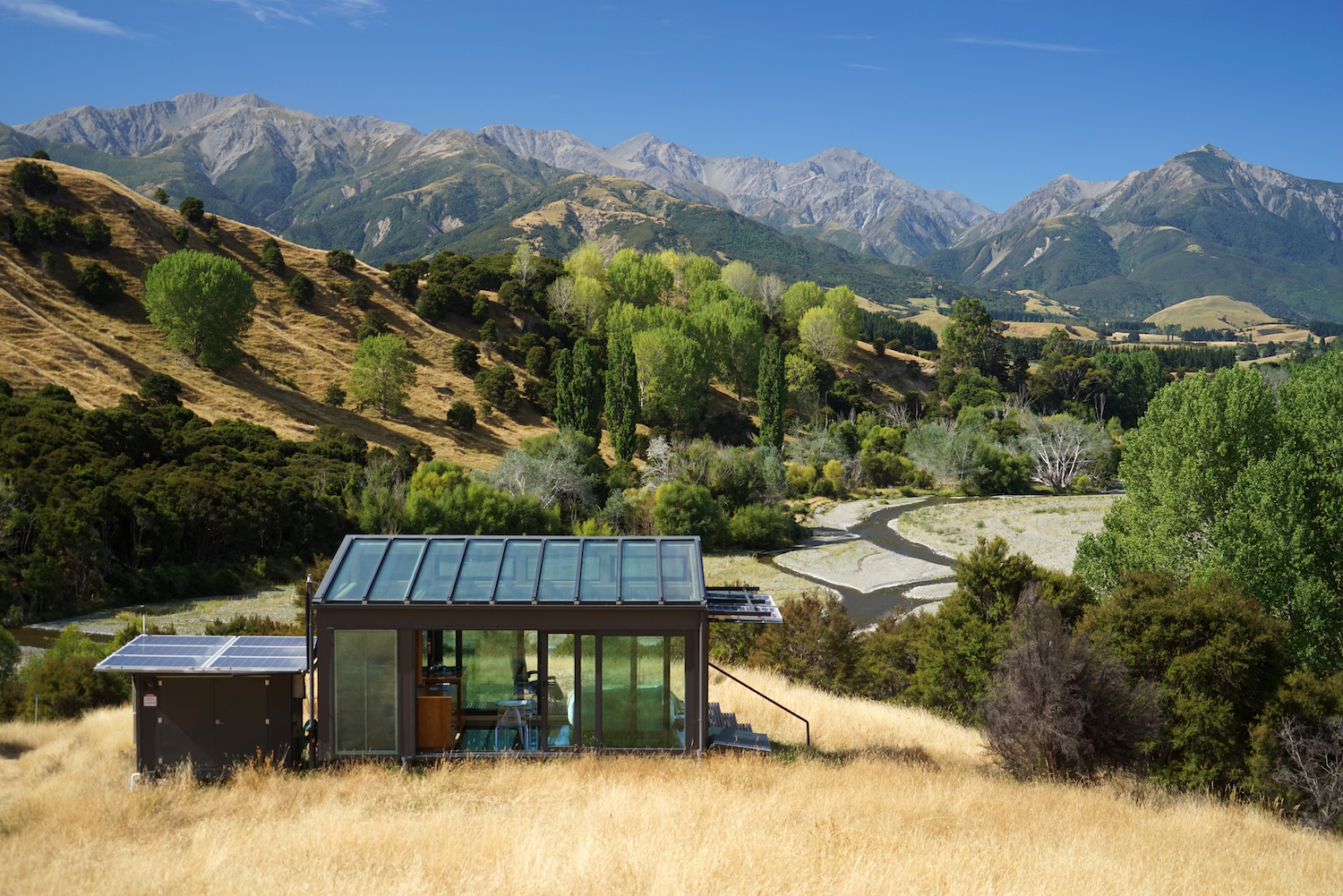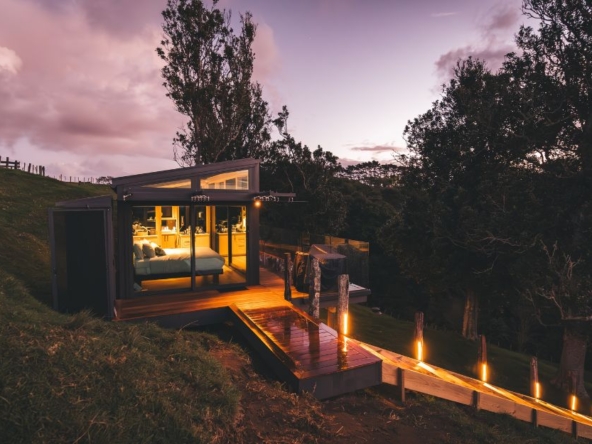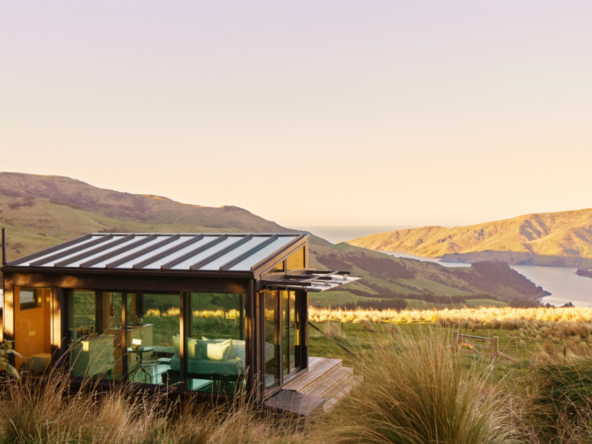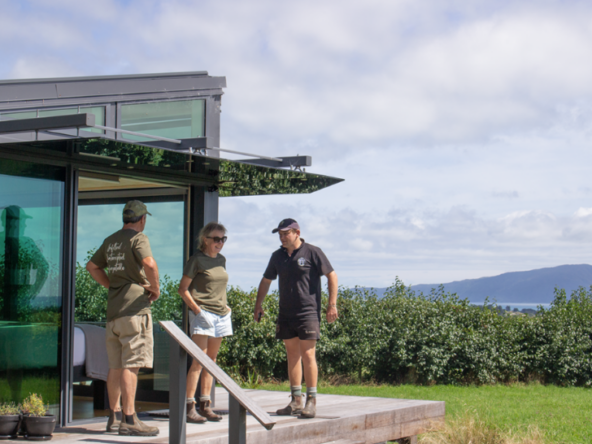Two glass cabins are part of a masterplan by a Kaikōura couple to keep the next generation on the family farm, writes Tim Cronshaw from Rural Life.
Early morning calls by stranded drivers to help them get through three fords comes with the territory for inland Kaikoura farmer Tony Blunt.
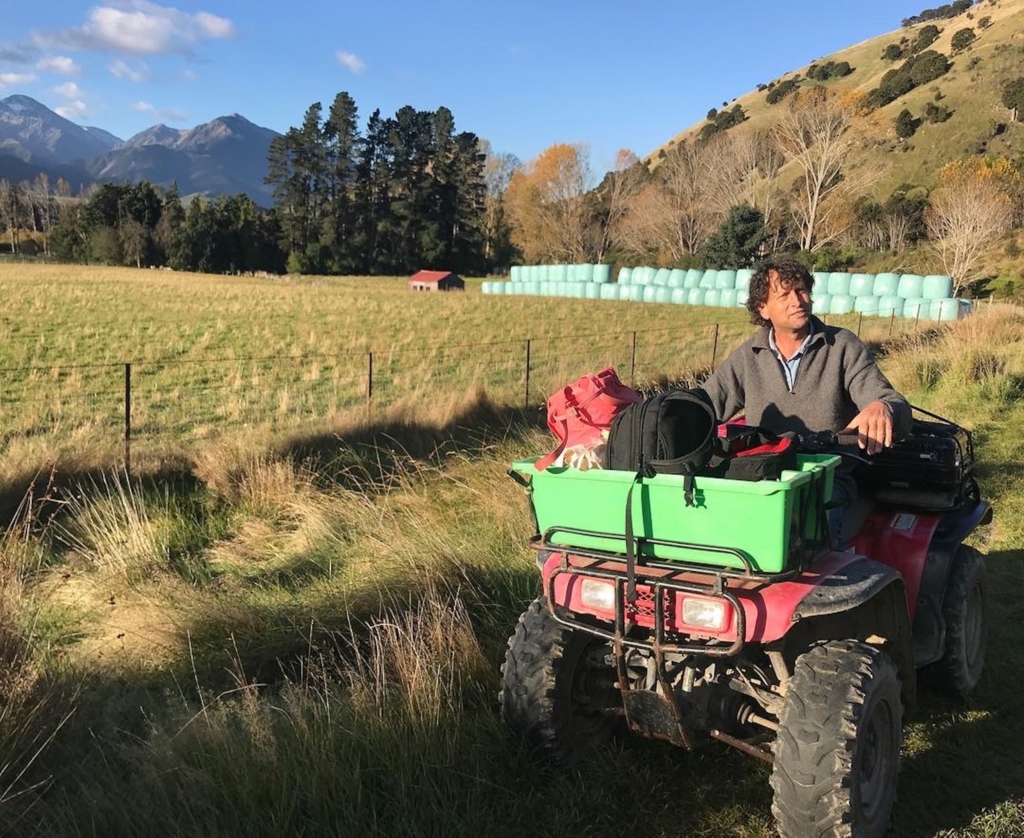
Before Covid 19 arrived, tourists often balked at taking vehicles across the stream and over the narrow bridge crossing Kahutara River.
So Tony would meet them down the road if it was raining and pick them up in the farm truck.
The tricky access is happily accepted as part of the back-country experience by visitors more accustomed to navigating traffic jams.
On arriving at the car park, they head to a small shed kitted out with jackets and gumboots.
Then off they go for a 900m walk to the first of two PurePods and a short distance further for the next one.
Breathtaking views
Tony and Angela never tire of their reaction when they open the door of the floor-to-ceiling glass cabin and look out across the river and beyond to the Seaward Kaikoura Ranges.
The couple have always had to be nimble on their feet to make the farm work. Hard graft, a bit of lateral thinking and good judgement calls have helped them get ahead.
They’d toyed with the idea of making the most of their magnificent scenery by building a cottage or hut to bring in more income.
In mid 2015, a friend who worked in the tourism industry suggested they look at a PurePods concept building at Little River.
Tony says they were instantly smitten by the glass-clad design with near 360 degree views.
The Kaikoura district councillor and Young Farmer of the Year in 1991 immediately made contact with the company.
The CEO came up to see their first site, saying little initially, until blurting out that the views were stunning. A weekend later an executive director and builder arrived.
‘‘They got out of the truck and went, ‘Holy smoke this is magic, we have to do one here’ and I said cool, hop in the truck I want to show you something else. We got out to the second site and they said ‘Holy smoke this is also a really cool site’ because you could see the river this way and the mountains the other way. They said ‘Should we build here or back to where we were’ and I went no, no why don’t we build two.’’
That made sense as couples or families often travel together and want their own space.
So they built a pair and some of the logic solving to make them work has become part of the model for future PurePods on other farms.
Steepdown Farm
Tony’s grandfather, Leslie, named the farm Steepdown 98 years ago, for good reason.
‘‘It’s bloody steep, 80% of it’s steep, hard hill country and 10% medium, easy rolling and 10% flat. You can’t get a horse around it.’’
They’ve got a small take from the river — 10 litres a second — which is a lifesaver in a drought.
Quickly gaining consent to irrigate was a wise move when they bought the hill block from his parents at the end of 1998.
Much of this was done on a shoestring budget, built from material lying around the farm. Tony visited a Swannanoa farmer irrigating with inch wide alkathene piping and a garden sprinkler on the end of it. On the way home he stopped at the rural service store and bought 20 sprinklers and 20 rolls of pipe.
Back at Steepdown he went along a line of two-inch pipe that a big pine tree had fallen on and everywhere there was a hole he put a tap saddle on. An old side roll pump picked up from Ashburton for $300 was engineered to their old Ford Dexta and that was his pump tractor for the first three years.
The whole lot was cobbled together for $1500 and irrigated 30ha on the flat.
At that stage, diesel was 35c a litre and there was good money to be made.
‘‘When things got dry there was a big difference between store lambs and the fat lamb market. Now it’s not so big and the price of diesel has gone through the roof. So we’ve had a few dry years and just sold store lambs.’’
Normally they have 50 Murray Grey Angus cross cows and winter 1200/1300 breeding ewes.
Flock numbers are down because they’ve had half their normal 75cm rainfall five of the past seven years.
Instead of borrowing the whole lot from the bank in one hit and struggling to pay interest, they paid for the property the old-fashioned way.
In the first seven years they were there, Tony would go contract fencing on Banks Peninsula three to four months of the year.
He specialised in the ‘‘gnarly stuff’’ — the steep country no one else wanted to do — often carrying in gear by hand or a four-wheeler and carrying out a lot of rock drilling.
There was a mountain of work and 14›hour days, but it was a means to an end to get them on top of debt — and through a nasty drought in their first year.
When his parents worked the farm, his mother went out on horseback with her dogs, shifting stock, and they employed a full timer and hired an international exchange student over the summer.
But they couldn’t afford staff so had to make the farm work themselves.
Those fencing years of hard graft paid off the first mortgage for the hill block and then the other half of the farm — bought in 2008. Tony did all the shearing. The 1800 Drysdale ewes and 500 wethers were shorn twice a year and one thousand lambs were shorn three times. The wether flock soon went down the road when the wool price dipped and later the Drysdales were replaced by Romneys and halfbreds.
In 2000/2001 another drought rolled along that was the worst for the district in living memory. By November, everything was brown, including the heavy paddocks around the house, and the first rain to turn anything green arrived in May, when they’d already had 14 frosts.
Only the lateral sprinklers saved them from destocking the property.
Most of the hay barns were empty so they sold all the lambs and started making and buying as much baleage and hay as they could to fill them up. This paid off when they started feeding out from February 1 to November 1 — including the twinning ewes through lambing.
By the beginning of September, they still had several barns full of 2›year›old meadow hay they paid $20 for now worth $100.
This was sold to pay for a larger irrigation pump and an old Ferguson 165 to drive it and four-inch aluminum pipes which were going cheap as others moved to centre pivots.
This made a lasting impression on Tony.
‘‘We learned some really good lessons from that. In my Dad’s lifetime he had to sell his whole cow herd three times. When they’ve learned to winter at 1000m above sea level in the tussock and matagouri country and you sell them you just can’t buy any old cows up there because they’ll just die. So the goal was to make sure we never had to sell any capital stock and we never have.’’
They like to cough up the money for diesel to run the irrigators so they can keep their lambs going to the day it rains. Then they sell them at better prices when farmers, who’ve been forced to offload before, have more feed and need stock.
Instead of buying stock every good year they make baleage so they have two years’ worth up their sleeve.
This doesn’t get sold until there’s a good dairy payout and a drought.
‘‘We tend to do the opposite of the 95% of other farmers. When suddenly they’ve got grass coming out of their ears they rush to the market and buy stock and the price will go crazy. That’s when we sell everything we’ve got to spare.’’
They cut and mow, often three paddocks at a time, to bypass the queue when everyone wants the baling contractor.
This light-of-foot thinking extended to carbon farming in 2008 when the Emissions Trading Scheme first came out.
The Blunts registered 155ha of regenerating native forest after unsuccessful attempts to develop it for grazing.
‘‘Over time, the kanuka keeps slowly creeping back and I kept on thinking that’s been the enemy for two of my generations, but if it can turn it into an income stream that’s not an enemy anymore.’’
Farm income
The three tonnes of carbon allocated at $20 something a tonne made sense when he couldn’t get three lambs off the country.
Even when the price dipped to $1.20/tonne they stuck with it and now it’s at $65/tonne and by far their biggest income earner.
They get a twin income from the flowering kanuka with a beekeeper paying a fee based on the honey price. The PurePods have brought in more revenue. The first one was finished in 2016 and the second soon afterwards, with Tony and the three boys helping with the build. They’re the brainchild of Grant Ryan, a serial inventor who, among many start-up projects, invented the electric situp straight YikeBike. Part of the deal is that the Blunts get a profit share of the rental revenue in exchange for providing the land, water and cleaning.
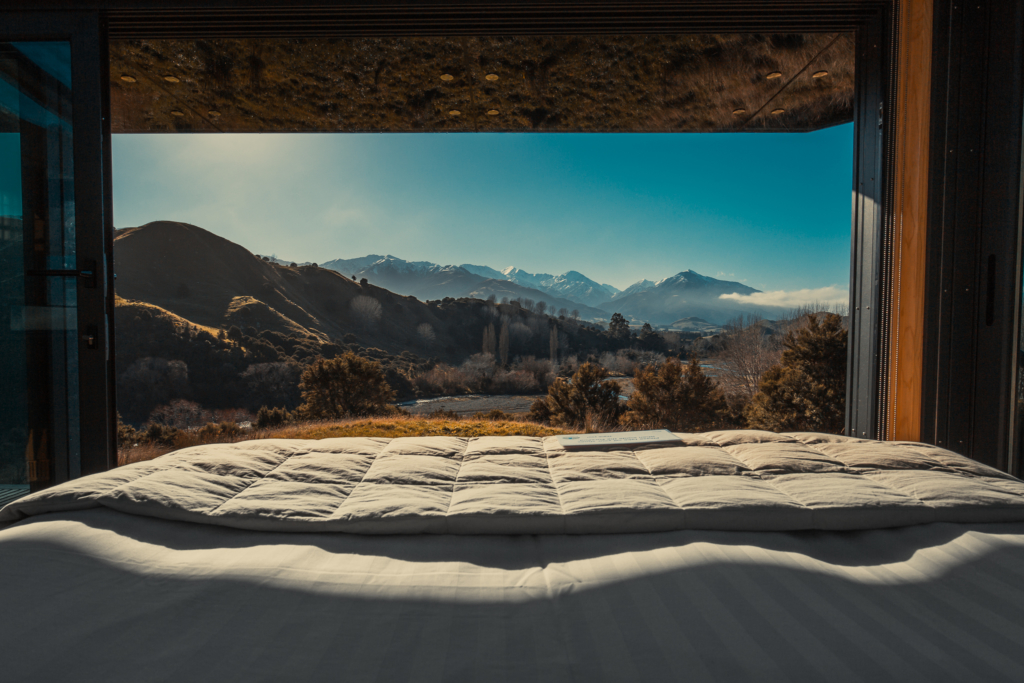
The opening was dashed when the Kaikoura earthquakes arrived on November 16, 2016, and there was no road into the farm for a month.
The PurePods escaped unscathed apart from a few wine glasses and coffee cups, but the old homestead and rest of the farm got hammered. The largest crack on the hill went down to 3m and was 7m wide. But the day power was restored they were open for business.
The Blunts were hoping for 50% occupancy but were blown away by the response.
Even with State Highway 1 still shut from Blenheim to Kaikōura they were full seven nights a week from October 2017 to the end of May.
Today, with the borders still closed to tourists they are happily ticking along at 50% full with just Kiwi guests.
The pods have meant they don’t muster on motorcycles or cut firewood in hearing distance so guests can enjoy the peace and tranquillity.
Cattle and glass buildings don’t go together so they’ve been removed from the two blocks, but people like the ewes with their lambs around.
Any minor inconvenience is heavily outweighed by the extra income.
Tony did the first 300 cleans himself to find out the expectations of guests and get their views on what worked well.
‘‘Sometimes people ring me and I tell them I’ve just been cleaning the pods and they say, ‘That must stink’. Well actually the view and the smell and the pay is a whole lot better up there than dagging lambs in my woolshed. I’ve been dagging lambs for 50 years and I know what I would rather be doing.’’
They’re thinking of other income streams they could introduce such as a NIWA weather station or more accommodation in the hunting block with even more spectacular views.
Cold press kanuka oil or charcoal production could be sustainable options.
PurePods venture helps diversify farm income for next generations
Tony says the PurePods partnership is part of the equation for keeping their children at Steepdown if they do the food and cleaning themselves and the occupancy returns to pre Covid levels.
‘‘Six or seven years ago when the carbon credit price was $1.20 and we had no PurePods this business would only have supported one family. Now with the carbon credits, the sheep and cattle, PurePods and the honey it could support three. I never thought in my wildest dreams I would be able to say that, but now actually I can and it’s a huge buzz.’’
By Tim Cronshaw, Rural Life

